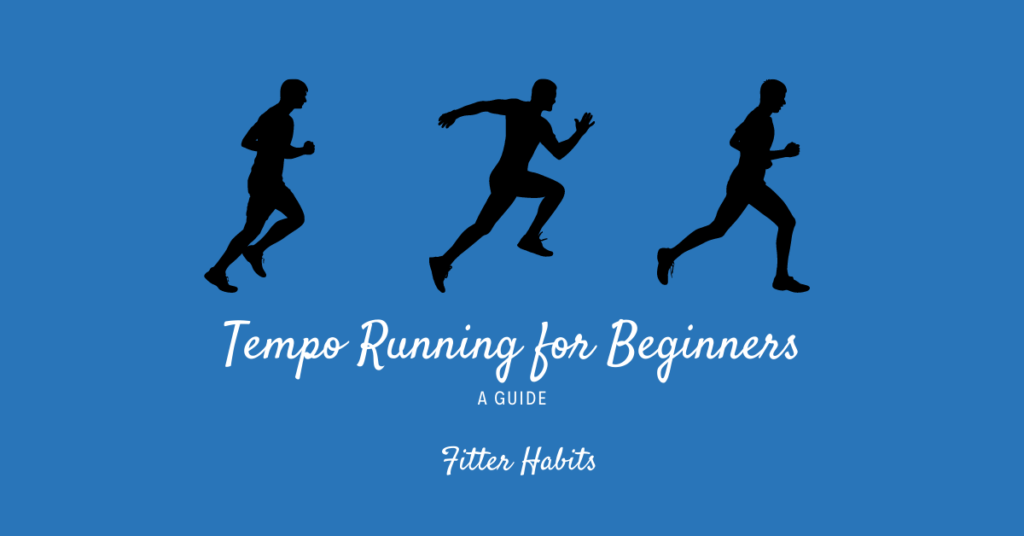Incorporating tempo running into your training can improve speed. Get started with this guide to tempo running for beginners.
Tempo runs are an effective way to increase your endurance and boost your speed as a runner. When I was first introduced to this type of running workout, I was skeptical. With regular training, however, tempo runs allowed me to improve my competitive racing times.
Below, I’ve summed up my knowledge in a quick guide to tempo runs for beginners. Read on to find out just what a tempo run is, how it makes you a better runner, and how to do one.
Contents
What Is a Tempo Run?

A tempo run is a popular method of speed work race training designed to ultimately make you faster — and thus result in better race times. It will serve you well in all types of distance running, whether you’re doing a 5k or a marathon training plan.
A tempo run workout consists of a sustained effort run, building up your physical ability to go harder, longer. Generally, this type of training involves running at 85 to 90 percent of your maximum heart rate.
The Lactate Threshold: The Key Characteristic of the Tempo Run
A tempo run is characterized by its pace, which is meant to be 25 to 30 seconds slower than the runner’s standard 5K race pace. According to the experts at Runner’s World, this is the pace at which your body can still clear as much lactate as it produces.
Lactic acid is a byproduct your body creates when burning carbohydrates. It’s responsible for that burning sensation you feel in rough longer races. Tempo runs are also called a lactate threshold or anaerobic threshold run.
In an actual race environment, you likely go beyond this lactate-balancing threshold. That’s why you get so exhausted when you’re pushing yourself. However, you should be able to hold a tempo pace for about 20 minutes before you get tuckered out.
Why You Should Incorporate Tempo Running into Your Training
Tempo running can help you get ready for any endurance event. The goal of this workout is to push yourself faster, harder, for longer periods. In doing so, you boost your aerobic fitness and cardiovascular health.
Tempo running for beginners can also help boost mental toughness. I underestimated the importance of mental resilience when I started running and later learned that this sport is often a question of “mind over matter.”
How to Figure Out Your Tempo
Never done a tempo run before? The first step is to figure out your tempo pace. Here are some running tips to help.
Take a Submaximal Exercise Test
As mentioned, a tempo run should be paced so that you end up working at about 85 to 90 percent of your max heart rate. This is about the equivalent of 80 to 90 percent of your VO₂ maximum — which reveals how much oxygen your body is absorbing when you exercise.
There are tests you can take to figure this out. A submaximal exercise test levels your body’s oxygen levels while running on a treadmill, for example. Some fitness instructors and trainers can conduct these tests.
Use a Heart Monitor
Heart rate monitors were once the domain of elite athletes. Now, anyone can buy a strap or even use ones found in popular running watches like the Garmin 245.
If you have one, warm-up for five or ten minutes. Then, run hard for two to three minutes. Repeat this two more times, trying to increase your speed each time. The third round should feel hard and fast.
Afterwards, check your heart rate monitor. The highest number of your three sprints is your maximum heart rate. You can now calculate what 85 to 90 percent of this number is and aim to hit that number for future tempo run workouts.
Refer to Your Racing Pace
If you don’t have the resources to take a submaximal exercise test or get a heart monitor, you can use your racing pace to figure out your tempo. For most distance runners, a tempo pace is somewhere between their half marathon pace and 10k speed.
Use this Conversation Rule
If you’re new to running or racing, it’s hard to understand the significance of stats second-hand. Here’s a useful rule of thumb: You know you’ve reached tempo speed if you can’t talk to the person running beside you because you’re out of breath.
Try running with a friend to figure out when you hit this limit. Training with a running buddy — especially one that’s faster than you — can also help motivate you to do better.
How to Include Tempo Runs into A Training Plan

Tempo runs are rigorous and can be daunting for new runners. Here’s how to incorporate them into your running routine without going overboard.
Start With Small Intervals
When you’re starting, you want to do smaller intervals, breaking up the run’s effort. Otherwise, you risk getting injured or burning out. Here’s one tempo run plan you can try:
- Do a one-mile tempo run
- Take a 60-second rest
- Return to your faster pace, repeating this interval two to four times
Increase Intensity
If you prefer, you can run for ten minutes instead of measuring by the mile. As you advance, you can upgrade the intensity of your tempo workouts like this:
- Go ten minutes at a comfortable run pace, where you can still carry on a conversation
- Go 20 minutes at your tempo run pace
- Rest by going ten minutes at your comfortable run pace again
How Often Should You Complete a Tempo Run?
Aim for one tempo run per week, as part of your broader running plan.
Make sure to follow up your tempo run day with an easy training day or a recovery day. You don’t want to push yourself too hard and increase your risk of runner injuries. Also, make sure to warm up and do a cooldown to stay safe.
If you are training for a race, you may want to decrease the number of tempo runs you do beforehand. You want to be well-rested and fully functional on race day — not recovering from a long-distance workout.
The Final Word on Tempo Running for Beginners
You will likely find this type of workout challenging at first but don’t fret: Tempo runs are supposed to be difficult. Even pro marathoners are exhausted after these grueling speed workouts.
Remember, you won’t improve if you aren’t pushing yourself. Completing a tempo run regularly will help you race longer distances and even cross the finish line with a new personal best.



